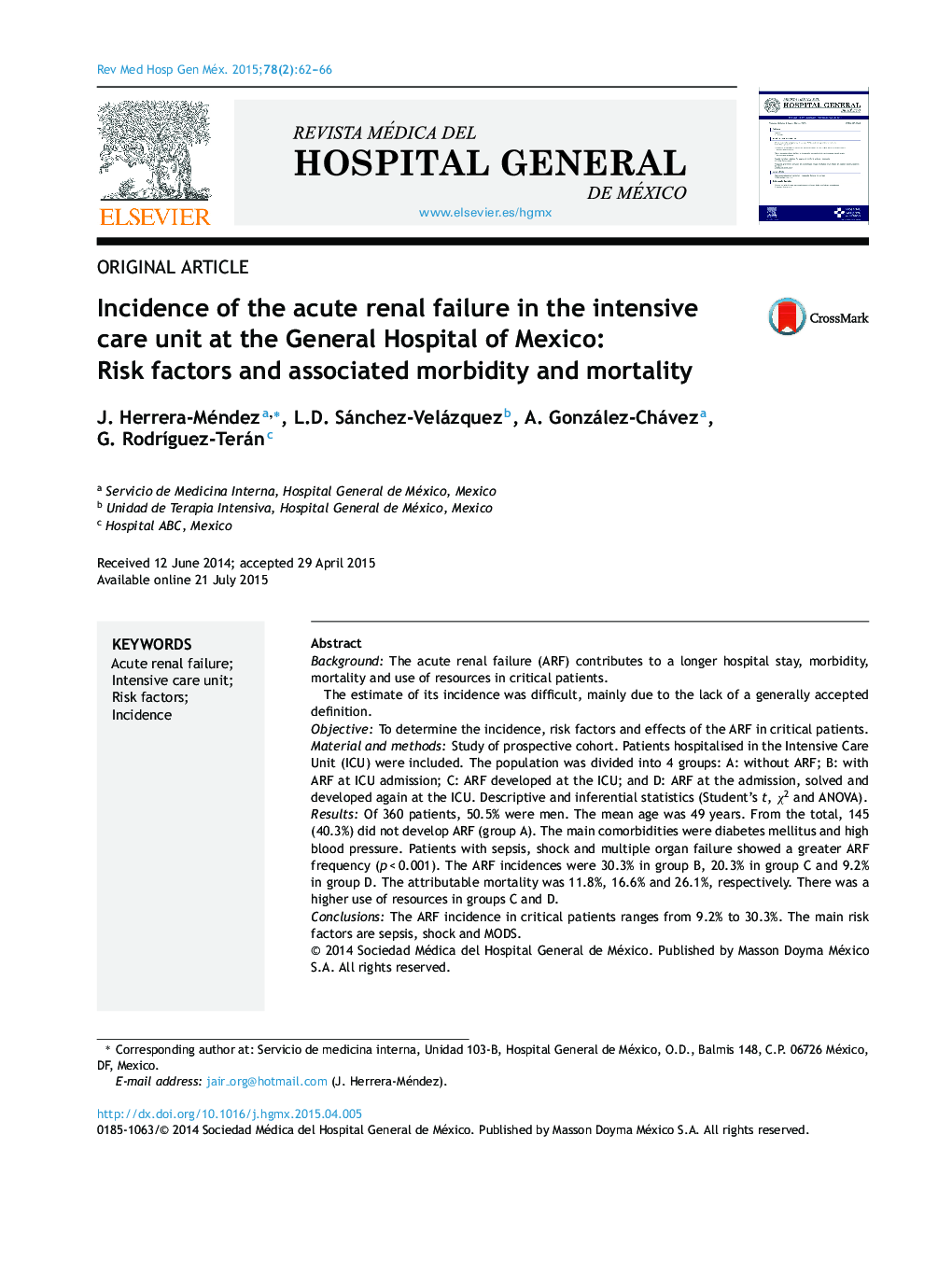| کد مقاله | کد نشریه | سال انتشار | مقاله انگلیسی | نسخه تمام متن |
|---|---|---|---|---|
| 3830906 | 1247194 | 2015 | 5 صفحه PDF | دانلود رایگان |
BackgroundThe acute renal failure (ARF) contributes to a longer hospital stay, morbidity, mortality and use of resources in critical patients.The estimate of its incidence was difficult, mainly due to the lack of a generally accepted definition.ObjectiveTo determine the incidence, risk factors and effects of the ARF in critical patients.Material and methodsStudy of prospective cohort. Patients hospitalised in the Intensive Care Unit (ICU) were included. The population was divided into 4 groups: A: without ARF; B: with ARF at ICU admission; C: ARF developed at the ICU; and D: ARF at the admission, solved and developed again at the ICU. Descriptive and inferential statistics (Student's t, χ2 and ANOVA).ResultsOf 360 patients, 50.5% were men. The mean age was 49 years. From the total, 145 (40.3%) did not develop ARF (group A). The main comorbidities were diabetes mellitus and high blood pressure. Patients with sepsis, shock and multiple organ failure showed a greater ARF frequency (p < 0.001). The ARF incidences were 30.3% in group B, 20.3% in group C and 9.2% in group D. The attributable mortality was 11.8%, 16.6% and 26.1%, respectively. There was a higher use of resources in groups C and D.ConclusionsThe ARF incidence in critical patients ranges from 9.2% to 30.3%. The main risk factors are sepsis, shock and MODS.
ResumenAntecedentesLa lesión renal aguda (LRA) contribuye a mayor estancia hospitalaria, morbilidad, mortalidad y consumo de recursos en pacientes críticos.Estimar su incidencia era complicado, principalmente por la falta de una definición generalmente aceptada.ObjetivoDeterminar incidencia, factores de riesgo y efectos de la LRA en pacientes críticos.Material y métodosEstudio de cohorte prospectiva. Se incluyeron pacientes hospitalizados en Unidad de Cuidados Intensivos (UCI). La población se dividió en 4 grupos: A. Sin LRA; B. con LRA al ingreso a UCI; C. LRA desarrollada en UCI; y, D. LRA al ingreso, resuelta y nuevamente desarrollada en UCI. Estadística descriptiva e inferencial (t de Student, χ2 y ANOVA).ResultadosDe 360 pacientes, 50.5% fueron hombres. La edad media fue 49 años. Del total, 145 (40.3%) no desarrollaron LRA (grupo A). Las principales comorbilidades fueron diabetes mellitus e hipertensión arterial. Los pacientes con sepsis, choque y falla multiorgánica presentaron mayor frecuencia de LRA (p<0.001). Las incidencias de LRA fueron 30.3% en el grupo B, 20.3% en el grupo C y 9.2% en el grupo D. La mortalidad atribuible fue de 11.8%, 16.6% y 26.1%, respectivamente. Hubo mayor consumo de recursos en los grupos C y D.ConclusionesLa incidencia de LRA en pacientes críticos oscila entre 9.2% y 30.3%. Los principales factores de riesgo son sepsis, choque y SDOM.
Journal: Revista Médica Del Hospital General De México - Volume 78, Issue 2, April–June 2015, Pages 62–66
